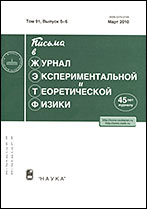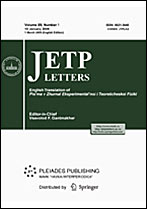|
This article is cited in 14 scientific papers (total in 14 papers)
CONDENSED MATTER
Cr-containing ferromagnetic film-topological insulator heterostructures as promising materials for the quantum anomalous Hall effect
E. K. Petrovab, I. V. Silkina, T. V. Menshchikovaa, E. V. Chulkovbcd
a National Research Tomsk State University, Tomsk, Russia
b St. Petersburg State University, St. Petersburg, Russia
c Departamento de Física de Materiales UPV/EHU, Centro de Física de Materiales CFM–MPC and Centro Mixto CSIC-UPV/EHU,
San Sebastián/Donostia, Spain
d Donostia International Physics Center (DIPC), San Sebastián/Donostia, Basque Country, Spain
Abstract:
Two heterostructures consisting of a Bi$_2$Se$_3$ topological insulator substrate and a CrI$_3$ or CrBi$_2$Se$_4$ ferromagnetic insulator thin film have been theoretically studied. The calculated band structure indicates that both heterostructures exhibit the quantum anomalous Hall effect with the splitting of the topological surface state of 19 and 92 meV for CrI$_3$/Bi$_2$Se$_3$ and CrBi$_2$Se$_4$ /Bi$_2$Se$_3$ , respectively. It has been shown that the band gap is determined primarily by the degree of localization of the wavefunction of the topological state in the ferromagnetic film. This degree of localization depends on the height and width of the interface barrier between the substrate and ferromagnetic material. Both the height and width of the interface barrier in the CrBi$_2$Se$_4$ /Bi$_2$Se$_3$ system are similar to the respective characteristics of the van der Waals barrier in bulk Bi$_2$Se$_3$.
Received: 06.11.2018
Revised: 21.11.2018
Accepted: 21.11.2018
Citation:
E. K. Petrov, I. V. Silkin, T. V. Menshchikova, E. V. Chulkov, “Cr-containing ferromagnetic film-topological insulator heterostructures as promising materials for the quantum anomalous Hall effect”, Pis'ma v Zh. Èksper. Teoret. Fiz., 109:2 (2019), 118–123; JETP Letters, 109:2 (2019), 121–125
Linking options:
https://www.mathnet.ru/eng/jetpl5804 https://www.mathnet.ru/eng/jetpl/v109/i2/p118
|


| Statistics & downloads: |
| Abstract page: | 260 | | Full-text PDF : | 37 | | References: | 40 | | First page: | 4 |
|



 Contact us:
Contact us: Terms of Use
Terms of Use
 Registration to the website
Registration to the website Logotypes
Logotypes